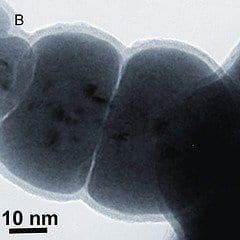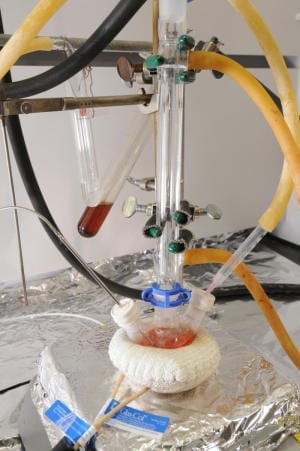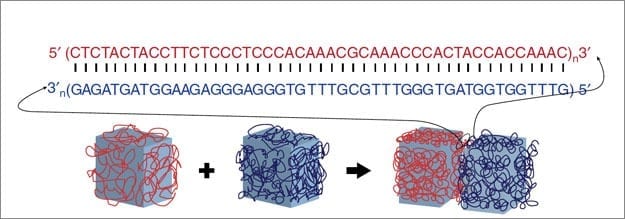
The nanoparticles were discovered accidentally on the rough surfaces of a reactor designed to grow carbon nanotubes
A nanoparticle shaped like a spiky ball, with magnetic properties, has been uncovered in a new method of synthesising carbon nanotubes by physicists at Queen Mary University of London and the University of Kent.
Carbon nanotubes are hollow, cylindrical molecules that can be manipulated to give them useful properties. The nanoparticles were discovered accidentally on the rough surfaces of a reactor designed to grow carbon nanotubes.
Described as sea urchins because of their characteristic spiny appearance, the particles consist of nanotubes filled with iron, with equal lengths pointing outwards in all directions from a central particle.
The presence of iron and the unusual nanoparticle shape could have potential for a number of applications, such as batteries that can be charged from waste heat, mixing with polymers to make permanent magnets, or as particles for cancer therapies that use heat to kill cancerous cells.
The researchers found that the rough surfaces of the reactor were covered in a thick powder of the new nanoparticles and that intentional roughening of the surfaces produced large quantities of the sea urchin nanoparticles.
“The surprising conclusion is that the sea urchin nanoparticles grow in vapour by a mechanism that’s similar to snowflake formation. Just as moist air flowing over a mountain range produces turbulence which results in a snowfall, the rough surface disrupts a flow to produce a symmetrical and ordered nanoparticle out of chaotic conditions,” said Dr Mark Baxendale from Queen Mary’s School of Physics and Astronomy.
On analysis, the researchers found that a small fraction of the iron inside the carbon nanotubes was a particular type usually only found in high temperature and pressure conditions.
Dr Baxendale added: “We were surprised to see this rare kind of iron inside the nanotubes. While we don’t know much about its behaviour, we can see that the presence of this small fraction of iron greatly influences the magnetic properties of the nanoparticle.”
The Latest Bing News on:
Revolution in manufacturing
- Inside India’s XR revolutionon April 27, 2024 at 9:50 pm
As we navigate through a transformative era shaped by Artificial Intelligence and Machine Learning, a new technological frontier is on the horizon — eXperiential Technologies (XT), also known as ...
- Driving India's Green Building Revolution: New National CII - IGBC Leadership Emergeson April 27, 2024 at 6:02 am
Through strategic partnerships and collaborative efforts, they aim to create a paradigm shift in the real estate and product manufacturing sectors, nurturing innovation, setting new standards for a ...
- Darren Handley (DHD) Remembers Shaping His First Board During the Thruster Revolutionon April 26, 2024 at 9:24 am
Darren Handley, the legendary shaper behind DHD surfboards, remembers shaping his first board – a gift for his little brother.
- Immortalising luxury: How brands can own the resale revolutionon April 25, 2024 at 9:31 pm
From resale to refurbs, Vogue Business and GXO examine how logistics can play a role in regenerating luxury past its point of sale. Sustainability and shoppers stand to benefit.
- The Difference Is the Data: Drug Discovery’s AI Revolutionon April 25, 2024 at 4:00 am
New data-intensive platforms continue to leverage artificial intelligence tools for improved speed and failure rate reductions for drug discovery.
- The AI and EV Revolution: Driving Increased Demand for Copperon April 24, 2024 at 11:06 pm
The surge in copper prices is emblematic of a broader shift in sentiment among traders and industry insiders, who are increasingly bullish on the metal’s prospects, particularly in light of its ...
- Paws for a Cause: Dog & Whistle's Sustainable Pet Food Revolutionon April 24, 2024 at 7:30 am
At Dog & Whistle, we take a comprehensive approach to food rescue and upcycling as part of our sustainable manufacturing process. Through our collaboration with distributors and restaurant partners, ...
- AI Analytics In Manufacturing: Top Strategies From Tech Expertson April 24, 2024 at 5:15 am
From optimizing processes to predicting equipment failures to better serving both customers and workers, the applications of AI in manufacturing are varied and valuable.
- Extreme Connect 2024: Wi-Fi 6E to drive connectivity revolution in infinite enterpriseon April 23, 2024 at 9:36 am
Extreme Networks kicks off annual conference with a launch it says will revolutionise outdoor connectivity through Wi-Fi 6E certification, with first significant customer deployments by leading ...
- The electric car revolution is on track, says IEAon April 22, 2024 at 11:55 pm
Global electric vehicle sales are set to rise by more than a fifth to reach 17 million this year, powered by drivers in China, according to the International Energy Agency.
The Latest Google Headlines on:
Revolution in manufacturing
[google_news title=”” keyword=”Revolution in manufacturing” num_posts=”10″ blurb_length=”0″ show_thumb=”left”]
The Latest Bing News on:
Nanoparticles
- Cow's milk particles unlock one of medicine’s most challenging puzzleson April 26, 2024 at 12:47 am
Cow’s milk contains nanoparticles that can be used to deliver disease-modifying RNA therapy orally, according to a new study. With RNA-based drugs currently only administrable by injection, the ...
- Cerium Oxide Nanoparticle Market worth US$ 5 billion by 2034on April 25, 2024 at 11:47 pm
The cerium oxide nanoparticle market is on a trajectory of substantial growth, with its size forecasted to surge from US$ 805.4 million in 2024 to an impressive US$ 5 billion by 2034. This exponential ...
- Ultrasensitive photonic crystal detects single particles down to 50 nanometerson April 24, 2024 at 12:49 pm
Using an ultrasensitive photonic crystal, TU/e researchers were able to detect single particles down to 50 nanometers in diameter. The new research has just been published in the journal Optica.
- Rice Bran Nanoparticles Could Be a Cheap Anticancer Agenton April 24, 2024 at 12:40 am
In advanced stages of cancer, tissue loss from treatments can be substantial and even fatal. Cutting-edge cancer therapies that employ nanoparticles can specifically target cancer cells, sparing ...
- Study could offer solution for reawakening responses from the immune systemon April 23, 2024 at 5:56 pm
Robert Clarke, PhD, executive director and professor, and Lu Jin, MS, researcher at The Hormel Institute, University of Minnesota, have co-authored a paper recently published in the journal ACS Nano.
- Breakthrough rice bran nanoparticles show promise as affordable and targeted anticancer agenton April 23, 2024 at 10:45 am
Plant-derived nanoparticles have demonstrated significant anticancer effects. Researchers recently developed rice bran-derived nanoparticles (rbNPs) that efficiently suppressed cell proliferation and ...
- Nanoparticles Deliver Drugs Directly Across the Blood-Brain Barrieron April 22, 2024 at 9:02 am
Recent studies published in Nature Communications by an international team of scientists from Michigan State University showed that nanoparticles can traverse the digestive system and deliver ...
- Researchers set new standards for nanoparticles, helping patients with MS, ALS, Parkinson's diseaseon April 19, 2024 at 9:31 am
Is it possible for nanoparticles to go through the digestive system and deliver medicine directly to the brain tissue? Researchers from Michigan State University say yes, and their latest findings are ...
- Metal Nanoparticles Market Size, Latest Trends, Share, Key Players, Revenue, Opportunity, and Forecast to 2024 to 2032on April 16, 2024 at 5:58 pm
Report Ocean recently published a research report titled “Metal Nanoparticles Market” 2024 Forecast to 2032 Analysis by Market Trends.” This study delivers accurate economic projections, worldwide ...
- Scientists solved the 70-year-old mystery of an insect's invisibility coat that can manipulate lighton April 15, 2024 at 10:13 am
A team of researchers created the world's first synthetic brochosomes in a huge step towards invisibility cloaking technology.
The Latest Google Headlines on:
Nanoparticles
[google_news title=”” keyword=”nanoparticles” num_posts=”10″ blurb_length=”0″ show_thumb=”left”]










